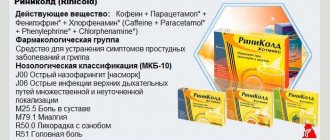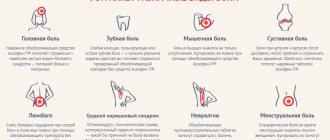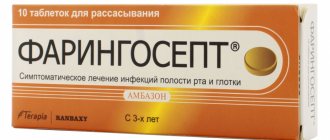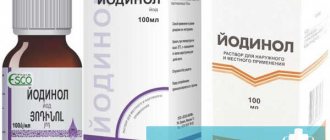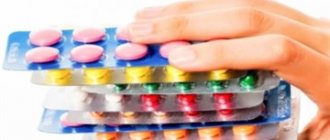Prohibited during pregnancy
Prohibited during breastfeeding
Prohibited for children
Has restrictions for older people
Has limitations for liver problems
Has limitations for kidney problems
Painful sensations accompany almost any disorder in the body. Often, paracetamol-based single medications are prescribed to relieve them, but if their use is ineffective, complex medications can be used. One of them is Trigan-D - a combined medication based on paracetamol and dicycloverine. This is an analgesic drug that does not contain psycholeptics.
Pharmacodynamics and pharmacokinetics
There is no information about Trigan-D on Wikipedia, and the interested category of people have questions “Trigan-D, what is it?” or “What is Trigan-D?”
The first component is paracetamol : it has an antipyretic, analgesic and weak anti-inflammatory effect. Inhibits cyclooxygenase of the first and second types in the nervous system and other tissues, as a result, the synthesis of prostaglandins - mediators of pain, regulation of body temperature and inflammation - stops.
The second component is dicycloverine hydrochloride : it has a small non-selective m-anticholinergic and myotropic antispasmodic effect on the smooth muscle cells of internal organs. In therapeutic doses, it has a relaxing effect on smooth muscles, not accompanied by atropine-like side effects.
The combined use of these two components allows for relaxation of the smooth muscle tissue of internal organs and relief of pain.
Pharmacokinetics
Well absorbed from the intestines. The maximum concentration in the blood is recorded after one hour. Paracetamol is transformed in the liver to form a number of metabolites, one of them N-acetyl-benzoquinomine can have a damaging effect on the kidneys and liver. 80% of the drug is excreted by the kidneys and in small amounts with feces.
First aid
The first thing to do when the victim shows the first signs of drug poisoning is to call a medical team.
Until the doctors arrive, the patient must be given first aid. Often, a person’s life and further successful treatment depend on timely action.
- Water in the amount of 1.5-2 liters is drunk by the victim at one time. Next, vomiting is induced to rid the body of the contents. This will help remove the toxic substance before it enters the bloodstream.
- To remove the compound that has already entered the blood, sorbents are given to drink, for example, activated carbon.
- Constantly offer excess fluids, eliminate the consumption of food and tablets. Water will help speed up the removal of poison from the body.
If the victim has lost consciousness, emptying the stomach is prohibited.
The patient is placed horizontally with his head tilted to the side. Check regularly for pulse and breathing. If necessary, perform indirect cardiac massage through the chest.
Indications for use
Indications for use (for which Trigan-D tablets are usually used):
- spasm of smooth muscle internal organs;
- algomenorrhea;
- hepatic, intestinal or renal colic ;
- neuralgia;
- toothache or headache ;
- myalgia;
- fever in infectious and inflammatory diseases .
Contraindications
- Sensitization to paracetamol or dicycloverine .
- Stomach or duodenal ulcer.
- Intestinal diseases complicated by obstruction.
- Hypovolemic shock.
- Reflux esophagitis.
- Myasthenia gravis.
- Lactation and pregnancy .
- Age less than 15 years.
The components of the drug in patients with liver or kidney disorders, glucose-6-phosphate dehydrogenase , glaucoma , blood diseases, hyperbilirubinemia, viral hepatitis, alcoholism and in old age can worsen the course of these diseases, from which Trigan-D tablets should be used in this category of people with extreme caution.
Use in childhood
The use of Trigan-D, even for the purpose of one-time spasm relief, is prohibited for persons under 15 years of age. Individual situations can be discussed with your doctor, and if the potential benefit outweighs the degree of harm, the specialist will prescribe an individual dosage of tablets and course duration. It is prohibited to give Trigan-D to a child without first consulting a doctor.
- Sulfonamide drugs - list. Mechanism of action of sulfonamides, use and contraindications
- What benefits are provided to disabled people of group 2?
- Nubuck - what kind of material is it, artificial and natural? Caring for nubuck shoes
Side effects
- Reactions from the digestive system: distortion of taste, stomach pain, decreased appetite, increased levels of liver enzymes , constipation, hepatonecrosis.
- Reactions from the nervous system: dizziness , drowsiness , agitation and disorientation.
- Allergic reactions: Quincke's edema , rash , urticaria , Stevens-Johnson syndrome, itching , Lyell's syndrome.
- Reactions from the hormonal system: hypoglycemia.
- Reactions from the excretory system: interstitial nephritis, urinary retention, pyuria , papillary necrosis , decreased potency.
- Reactions from the hematopoietic system: methemoglobinemia, hemolytic anemia.
- Reactions from the vision: mydriasis, paralysis of accommodation, blurred vision, increased intraocular pressure.
Dosage and side effects
Taking Trigan-D in some cases can cause negative consequences. This happens rarely, but if you notice unpleasant symptoms, you should stop taking the drug and seek medical help.
Side effects:
- On the digestive side, there may be a deterioration in appetite, dry mouth and decreased taste.
- Nervous system - headache, drowsiness, problems with orientation in space and dizziness.
- Endocrine disorders can lead to a significant increase in blood glucose levels, which can lead to coma.
- Genitourinary system - impaired kidney function, problems with urination and pus in the urine. In rare cases, a decrease in male potency is observed.
- Malfunctions in the functioning of the visual organs - impaired accommodation of the eye, dilated pupils and decreased clarity of vision.
- Blood - hemolytic anemia and methemoglobinemia.
- Various allergic reactions - itching, rash, Quincke's edema, urticaria and skin necrosis.
A very important point is to maintain the correct dosage. If you take more medicine than you should, instead of having a therapeutic effect, you will end up poisoning the body.
Trigan-D tablets should be taken after meals, swallowed whole and washed down with the required amount of water. A single dose of medication should not exceed 2 tablets, and a daily dose should not exceed 4. Treatment of pain syndrome lasts no more than 5 days in a row. Use as an antipyretic – 3 days. A longer course should be prescribed by a doctor.
Trigan-D tablets, instructions for use (Method and dosage)
Instructions for use on Trigan-D recommend taking the drug orally, 1 tablet up to three times a day. The largest single dose is two tablets, the daily dose is four tablets. Duration of administration is no more than five days when used as an analgesic and three days when used as an antipyretic.
It is not recommended to exceed the daily dose, since an overdose of the drug causes liver failure, for which Trigan-D (if it is necessary to increase the dose or increase the standard duration of treatment) must be used under the supervision of a physician.
First aid and treatment for overdose.
If signs of overdose are detected, you should call an ambulance. This must be done because it will be difficult to provide first aid in case of poisoning with signs of drug addiction, for example, to rinse the stomach. The poisoned person will behave inappropriately or be unconscious. In the latter case, before the specialists arrive, the person should be placed on his side so that he does not choke on the vomit.
As antidotes, intravenous administration of methionine is used - after 8 hours, and after 12 hours - N-acetylcysteine. Treatment of an overdose with Trigan D occurs only in a hospital setting. If necessary, a psychiatrist is involved.
Trigan-D is a simple medicine found in your home medicine cabinet. It is used to relieve pain of various etiologies. However, this drug is often used by young people as a drug substitute. As a rule, when asking a pharmacist for an inexpensive medicine for pain in the muscles or head, patients are offered a drug from India. It shows results and more.
Overdose
Overdose of Trigan-D, symptoms: tachypnea, tachycardia, fever, convulsions, agitation, pain in the stomach, decreased appetite, thrombocytopenia, anemia, nephrotoxicity, hemolytic or aplastic anemia, pancytopenia, methemoglobinemia, hepatonecrosis.
Therapy: stop using the drug, perform gastric lavage, take adsorbents , agents that stimulate the formation of glutathione (for example, acetylcysteine ) and activate conjugation ( methionine ).
Interaction
The effects of dicycloverine are stimulated by first class antiarrhythmic drugs benzodiazepines, narcotic painkillers, MAO inhibitors, sympathomimetics, nitrates, nitrites, tricyclic antidepressants.
Dicycloverine increases the level of dioxin in the blood.
Enhancers of microsomal oxidation ( ethanol, barbiturates, rifampicin, tricyclic antidepressants ) stimulate the synthesis of hydroxylated metabolites in the liver, this can lead to the development of severe intoxication even with mild overdoses of paracetamol .
Inhibitors of microsomal oxidation reduce the possibility of hepatotoxicity .
Adrenergic stimulants and anticholinergic drugs increase the risk of unwanted effects.
Paracetamol activates the action of indirect anticoagulants.
Consequences
Using this drug in doses that do not comply with the instructions will sooner or later lead to serious consequences. Any violation of the regulations is manifested by intoxication or poisoning of the body, and poison, as is known, tends to accumulate in the body.
Symptoms of abuse of this drug:
- decreased or loss of vision;
- muscle atrophy and destruction;
- violation of movement coordination;
- liver destruction;
- kidney failure;
- hypoglycemic coma (sharp decrease in blood sugar levels).
Analogs
Level 4 ATC code matches:
Phenacetin
Combiflu
Chlorphenamine
Coldflu
Calpol
Fervex
Panadol Extra
Panadol for children
Panadol
Solpadeine
Efferalgan
Milistan
Coldrex Maxgripp
Coldrex Hotrem
Coldrex
AntiGrippin
Unispaz
Pentalgin Plus
Rapidol
Maxicold
Duspatalin, Mebsin Retard, Moreaze SR, Trimpa.
Reviews about Trigan-D
According to reviews, the product helps to effectively relieve spasms and pain in the vast majority of cases.
paracetamol are also known . As a result, after consuming the resulting substance, side effects occur on the psyche and nervous system, called “highs.” You should know that this is an extremely harmful effect that can lead to irreparable consequences. On specialized forums, you often encounter questions like “how to remove paracetamol from Trigan to get the drug?” We strongly advise you not to engage in such experiments with medications and your body.
Trigan-D price, where to buy
The average price of Trigan D No. 100 in Ukraine is 302 hryvnia, and in Russia – 316 rubles.
- Online pharmacies in RussiaRussia
- Online pharmacies in UkraineUkraine
ZdravCity
- Trigan-D tablets 500 mg 100 pcs. Cadila Pharmaceuticals Ltd.
RUB 329 order - Trigan-D tablets 500 mg 20 pcs. Cadila Pharmaceuticals Ltd.
129 RUR order
- Trigan-D tab. No.10Cadila Pharmaceuticals Ltd.
66 RUR order
show more
Release form and composition
Trigan-D is available in the form of tablets: round, flat, with a smooth surface and beveled edges, white, with a score on one side (10 pieces in blisters or strips, 2 blisters or 10 strips in a cardboard pack).
Composition per 1 tablet:
- active ingredients: dicycloverine hydrochloride – 20 mg, paracetamol – 500 mg;
- auxiliary components: maize starch, povidone, sodium starch glycolate, magnesium stearate, microcrystalline cellulose, colloidal silicon dioxide.
